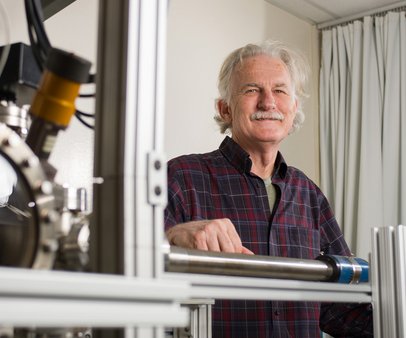Goodbye Ohm - Hello Heisenberg
Research reported earlier this month shows that electrical resistance in
nanoribbons of epitaxial graphene changes in discrete steps following
quantum mechanical principles.
In plain language, electron transport in a new variant of graphene doesn't obey Ohm's law: the resistance of the material is independent of current. However, unlike the case with a normal conductor where you can stick a multimeter across any two points on a wire and measure the voltage, if you probe this new material you increase the resistance. Shades of Heisenberg.

Walt de Heer
“This work shows that we can control graphene electrons in very
different ways because the properties are really exceptional,” said Walt de Heer, a Regent’s professor in the School of Physics
at the Georgia Institute of Technology. “This could result in a new
class of coherent electronic devices based on room temperature ballistic
transport in graphene. Such devices would be very different from what
we make today in silicon.”
...
The research shows that the graphene nanoribbons act more like
optical waveguides or quantum dots, allowing electrons to flow smoothly
along the edges of the material. In ordinary conductors such as copper,
resistance increases in proportion to the length as electrons encounter
more and more impurities while moving through the conductor.The
ballistic transport properties, similar to those observed in cylindrical
carbon nanotubes, exceed theoretical conductance predictions for
graphene by a factor of 10. The properties were measured in graphene
nanoribbons approximately 40 nanometers wide that had been grown on the
edges of three-dimensional structures etched into silicon carbide
wafers....
De Heer argues that researchers should stop trying to use graphene
like silicon, and instead use its unique electron transport properties
to design new types of electronic devices that could allow ultra-fast
computing – based on a new approach to switching. Electrons in the
graphene nanoribbons can move tens or hundreds of microns without
scattering.“This constant resistance is related to one of the
fundamental constants of physics, the conductance quantum,” de Heer
said. “The resistance of this channel does not depend on temperature,
and it does not depend on the amount of current you are putting through
it.”What does disrupt the flow of electrons, however, is
measuring the resistance with an electrical probe. The measurements
showed that touching the nanoribbons with a single probe doubles the
resistance; touching it with two probes triples the resistance.“The
electrons hit the probe and scatter,” explained de Heer. “It’s a lot
like a stream in which water is flowing nicely until you put rocks in
the way. We have done systematic studies to show that when you touch the
nanoribbons with a probe, you introduce a method for the electrons to
scatter, and that changes the resistance.”
Source: Georgia Tech.


